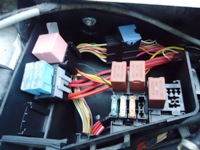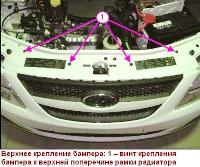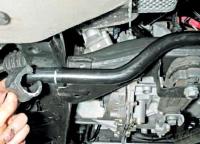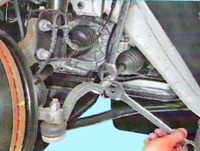This article describes the diagnostic procedure used for the air conditioning system of the LADA LARGUS car
Required diagnostic equipment and instruments:
- - diagnostic device DST-12 (firmware RF90);
- - multimeter;
- - universal contact board.
General instructions for diagnostics
To diagnose the air conditioning system, it is necessary to connect the diagnostic tool, turn on the ignition and perform the necessary operations (checking for malfunctions, monitoring the compliance of the data transmitted by the controller) regarding the air conditioning system, in accordance with the requirements of TI 3100.25100.12041 "Diagnostics of the ECM of a LADA LARGUS car" .
Troubleshooting Algorithm (FLS)
If no faults are found by checking with the diagnostic tool, but the fault persists, use the appropriate ALP to correct the fault.
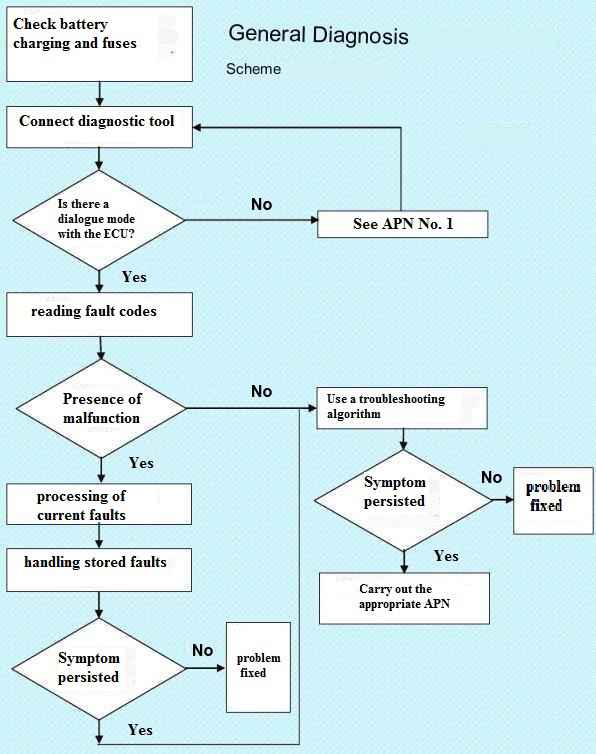
The general scheme for performing diagnostics is shown in Figure 1 in the form of a flowchart.
Checking the wiring
Difficulties in diagnosis
By disconnecting the connectors and/or moving the wiring harnesses, the cause of the malfunction can be instantly corrected.
Voltage, resistance and insulation resistance measurements usually give the correct measured values, especially if the fault is not present (stored) at the time of testing.
Visual check
Find signs of damage in the engine compartment and cabin.
Carefully check the protective covers, the integrity of the insulation and the correct routing of the wiring harnesses.
Look for traces of oxidation.
Check by touch
While wiggling and twisting the wiring harnesses, use a scan tool to determine when the fault transitions from "stored" to "current".
Make sure the connectors are secure.
Move the connectors a little.
Twist the wiring harness.
If there has been a change in the state of the fault, try to determine its cause.
Checking individual elements
Disconnect the connectors and check the condition of the clamps and contacts, as well as their crimping (there should be no signs of crimping on the insulation).
Check that the clamps and contacts are securely fixed in the sockets of the connector.
Make sure that the clips and contacts are not squeezed out when connecting the connector.
Check the contact pressure of the clamps using a suitable type of contact lead.
Resistance test
First, check the integrity of the entire chain, then in separate sections. Determine if there is a short to ground, to + 12 V or to another wire.
If a malfunction is found, repair it or replace the wiring.
Troubleshooting algorithms:
- Faults detected during the operation of the air conditioning system - APN number
- No communication with ECM - CHART 1
- No cooling - ALP 2
- Insufficient cooling - CHART 3
- Excessive compressor noise - ALP 4
- High discharge pressure - ALP 5
- Low discharge pressure - ALP 6
Before starting troubleshooting, it is necessary to check the ECM using a diagnostic tool in accordance with the requirements of TI 3100.25100.12041 "Diagnostics of the ECM of a LADA LARGUS car" for the presence of fault codes related to the operation of the air conditioning system.
Transcript
CHT 1 - No communication with ECM
No diagnostic hints
Verify that the diagnostic tool is not the cause of this problem by checking it when communicating with the ECU on another vehicle.
If the device is not the cause of this malfunction, but the dialogue mode is not established with any other ECU of the same vehicle, it is possible that one of the ECUs is malfunctioning, which disrupts the diagnostic K-line
Sequentially disconnect the computer connectors to determine which one is faulty.
Troubleshoot if necessary.
Check the battery voltage and do the necessary work to get the correct voltage (9.5 V < battery voltage < 17.5 V).
Check for 12 V voltage on track "16" of the diagnostic connector.
If necessary, repair the fault in the circuit up to the fuse.
Check for the presence of "ground" on pins "4" and "5" of the diagnostic connector.
Troubleshoot if necessary.
Using the universal contact board, check for an open or short circuit in circuits:
- - ECU, terminal "28" - "ground";
- - ECU, terminal "33" - "ground";
- - ECU, pin "3" - "ground";
- - ECU, pin "56" - pin "7" of the diagnostic connector;
- - ECM, pin "26" - pin "15" of the diagnostic connector;
- - ECU, terminal "29" - fuse;
- - ECU, terminal "30" - fuse.
Troubleshoot if necessary.
After troubleshooting, perform a system check using the diagnostic tool.
APN 2 - No Cooling
Diagnostic hints
Perform after a complete check of the air conditioning system using a diagnostic tool.
- Heater fan does not work
Make sure the heater fan is working:
- - check fuses F36 and F39;
- - check the serviceability of the additional resistor;
- - check the wiring;
- - check the health of the heating, air conditioning and ventilation control unit.
Repair if necessary, replace defective elements.
- Compressor not working
Check fuse F01;
Check for open and short circuits in circuits:
- - heating, air conditioning and ventilation control unit, pin "5" - pin "46" of the ECM;
- - fuse F01, contact "S" - contact "B3" of the air conditioning compressor relay;
- - air conditioning compressor relay, contact "B5" - contact "1" of the electromagnetic clutch of the air conditioner;
- - A/C compressor relay, terminal "B2" - terminal "10" of the ECM;
- - air conditioning compressor relay, contact "B1" - contact "A5" relay actuators;
Troubleshoot if necessary.
Check the operation of the compressor electromagnetic clutch.
Replace the compressor if necessary.
- Not enough refrigerant in the system
Make sure there is enough refrigerant in the air conditioning system:
- - check the refrigerant charge level;
- - make sure there are no refrigerant leaks.
Fix refrigerant leaks if necessary, restore refrigerant level.
APN 3 - Insufficient cooling
Diagnostic hints
Perform after a complete check of the air conditioning system using a diagnostic tool.
- Cabin air filter dirty
Make sure there is no dirt on the surface of the cabin air filter.
If necessary, clean or replace the cabin ventilation filter.
- Heater fan does not work
Make sure the heater fan is working:
- - check fuses F36 and F39;
- - check the serviceability of the additional resistor;
- - check the wiring;
- - check the health of the heating, air conditioning and ventilation control unit.
Repair if necessary, replace defective elements.
- Accessory drive belt slip
Check for slippage of the accessory drive belt.
If necessary, replace the accessory drive belt.
- Condenser dirty
Make sure there is no dirt on the surface of the condenser.
Clean the condenser if necessary.
- Not enough refrigerant in the system
Make sure there is enough refrigerant in the air conditioning system:
- - check the refrigerant charge level;
- - make sure there are no refrigerant leaks.
Fix refrigerant leaks if necessary, restore refrigerant level.
- The thermostatic expansion valve (TRV) is defective
Make sure there is enough refrigerant in the air conditioning system:
- - check if the TRV is installed correctly;
- - check if the expansion valve is dirty or jammed;
- - check if the TEV grid is full;
- - make sure that there is no leakage in the thermal bulb of the expansion valve;
- - make sure that the expansion valve opens and closes.
Replace expansion valve if necessary.
- Evaporator icing
Make sure the heater fan is working:
- - check fuses F36 and F39;
- - check the serviceability of the additional resistor;
- - check the wiring;
- - check the health of the heating, air conditioning and ventilation control unit.
If necessary, troubleshoot, replace faulty elements cops.
Make sure there is no dirt on the surface of the evaporator:
If necessary, clean the evaporator.
Make sure the receiver dryer is not clogged.
If necessary, replace the receiver dryer.
Make sure there is no moisture in the system.
If necessary, perform the following procedure:
- - unload refrigerant from the system;
- - replace receiver dryer;
- - drain and prime the system.
- Dirty receiver drier drier
Check that the receiver-dryer is not dirty.
If necessary, replace the receiver dryer.
- Presence of air and non-condensable gases in the system
Make sure there is no air or non-condensable gases in the system.
If necessary, bleed air and non-condensable gases from the system.
- Faulty compressor valves
Make sure the compressor valves are working
Replace the compressor if necessary.
After troubleshooting, check the air conditioning system
APN 4 - Increased compressor noise
Diagnostic hints
Perform after a complete check of the air conditioning system using a diagnostic tool.
- Lack or excess of oil in the system
Check the oil level in the air conditioning system.
If necessary, top up the oil level.
- Excessive amount of refrigerant in the system
Check the refrigerant level in the air conditioning system.
Remove excess refrigerant from the system if necessary.
- Compressor magnetic clutch power supply failure or low
Measure the supply voltage of the compressor electromagnetic clutch.
Check the connections in the electrical wiring.
Repair if necessary, replace compressor.
- Compressor mounting elements loose
Make sure that the compressor mounting elements are securely fastened.
Tighten the compressor mounting bolts if necessary.
- Compressor parts worn or broken
Check for wear and damage to compressor parts.
Replace the compressor if necessary.
After troubleshooting, check the air conditioning system
CHART 5 - High discharge pressure
Diagnostic hints
Perform after a complete check of the air conditioning system with the diagnostic tool and if parameter PR037 Refrigerant pressure is above the maximum allowable value (> 6 bar).
- High ambient temperature
Make sure that the ambient temperature does not exceed +45°C.
If necessary, test the system in a room with air temperature up to 45°C.
- Excessive amount of refrigerant in the system
Check the refrigerant level in the air conditioning system.
Remove excess refrigerant from the system if necessary.
- Condenser dirty
Make sure there is no dirt on the surface of the condenser.
Clean the condenser if necessary.
- Engine cooling fan not working
Make sure the engine cooling fan is working:
- - check fuses;
- - check the serviceability of the additional resistor;
- - check the wiring;
Repair if necessary, replace defective elements.
- Heater fan does not work
Make sure the heater fan is working:
- - check fuses F36 and F39;
- - check the serviceability of the additional resistor;
- - check the wiring;
- - check the health of the heating, air conditioning and ventilation control unit.
Repair if necessary, replace defective elements.
- Presence of air and non-condensable gases in the system
Make sure there is no air or non-condensable gases in the system.
If necessary, bleed air and non-condensable gases from the system.
After troubleshooting, check the air conditioning system
CHART 6 - Low discharge pressure
Diagnostic hints
Perform after a complete check of the air conditioning system with the diagnostic tool and if parameter PR037 Refrigerant pressure is below the minimum value (< 2 bar).
- Not enough refrigerant in the system
Make sure enough refrigerant in the air conditioning system:
- - check the refrigerant charge level;
- - make sure there are no refrigerant leaks.
Fix refrigerant leaks if necessary, restore refrigerant level.
- Low ambient temperature
Make sure that the ambient temperature is not lower than +10°С.
If necessary, test the system in a room with an air temperature above +10°C.
- Accessory drive belt slip
Check for slippage of the accessory drive belt.
If necessary, replace the accessory drive belt.
- Faulty compressor valves
Make sure the compressor valves are working
Replace the compressor if necessary.
After troubleshooting, check the air conditioning system







